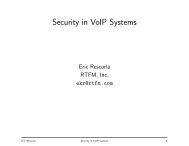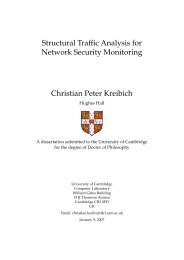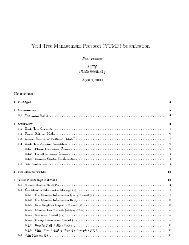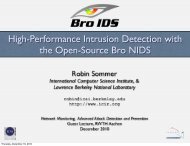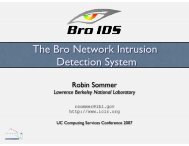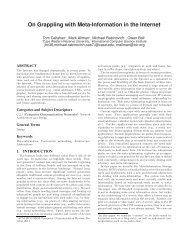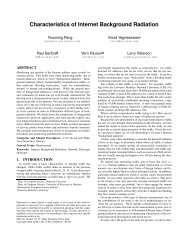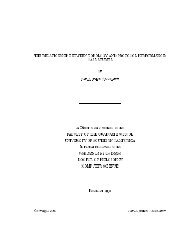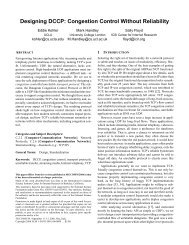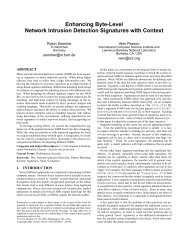SIFF: A Stateless Internet Flow Filter to Mitigate DDoS Flooding Attacks
SIFF: A Stateless Internet Flow Filter to Mitigate DDoS Flooding Attacks
SIFF: A Stateless Internet Flow Filter to Mitigate DDoS Flooding Attacks
You also want an ePaper? Increase the reach of your titles
YUMPU automatically turns print PDFs into web optimized ePapers that Google loves.
(a) Marking scheme for EXPLORER packets. Routers push their markings in<strong>to</strong> the least significant<br />
bits of the capability field. Packets with a capability field of all zeros get marked with an additional 1<br />
bit.<br />
(b) Authentication scheme for DATA packets. Routers check the marking in the least significant bits<br />
of the capability field, and rotate it in<strong>to</strong> the most significant bits, if it is equal <strong>to</strong> what the marking<br />
would be for an EXPLORER packet.<br />
(c) Windowed authentication and marking for DATA packets. Routers check that the marking equals<br />
one of the valid markings in its window and always rotate the newest marking in the window in<strong>to</strong> the<br />
capability field.<br />
Figure 2. Marking and authentication schemes for EXPLORER and DATA packets.<br />
When the EXP packet arrives at the server, the server creates<br />
a response packet. The response packet is also an EXP<br />
packet, with the Capability field initialized <strong>to</strong> zero, but<br />
with the capability update (CU) flag set, and the Capability<br />
Reply field initialized <strong>to</strong> the contents of the Capability<br />
field of the EXP packet from the client. When the<br />
server’s EXP packet arrives at the client, the client examines<br />
the Capability Reply field, takes all the bits up<br />
<strong>to</strong>— but not including— the most significant 1 bit in the<br />
packet, splits them in<strong>to</strong> groups of z bits and reverses the order<br />
of the groups <strong>to</strong> obtain its capability. This capability is<br />
inserted in<strong>to</strong> the Capability field of all subsequent privileged<br />
packets that the client sends. To complete the handshake,<br />
the client must send the server its capability, marked<br />
by the routers in the server’s EXP packet’s Capability<br />
field. The client creates a DTA packet, with the CU flag set<br />
and the Capability field from the server’s EXP packet<br />
in the Capability Reply field; just as the server did<br />
for the client.<br />
The router behavior for marking and forwarding DTA<br />
packets is different from that used for EXP packets. When<br />
a router receives a DTA packet, it calculates a marking<br />
as though the packet were an EXP packet, but then only<br />
verifies that the marking it has calculated is equal <strong>to</strong> the<br />
marking in the least significant bits of the Capability<br />
field. If the marking is not equal, then the packet is immediately<br />
dropped. If the marking is equal, then the router<br />
right shifts that marking in<strong>to</strong> the most significant bits of<br />
6




